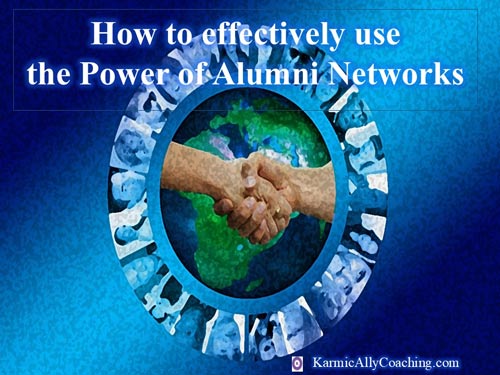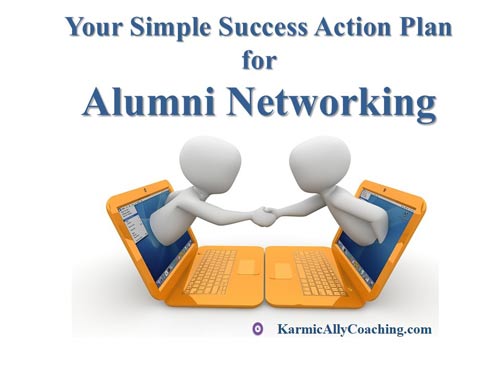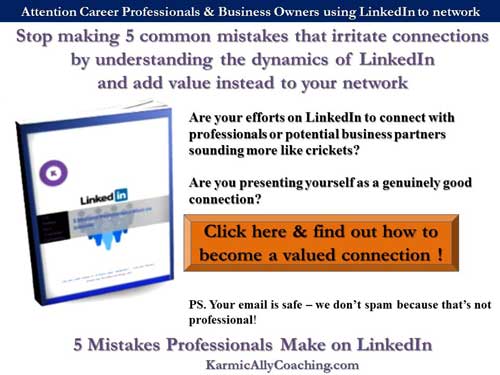
Some time back an alumni of mine and I both noticed a new trend on LinkedIn of people openly asking strangers for help in getting a job without first building a relationship that would provide a basis for a credible referral or introduction.
Even though I’m not a recruiter or in the Executive Search industry, it doesn’t prevent professionals for wanting to connect with me on LinkedIn in case I can help them get a job or at least introduce them to someone who could.
Of course I give them guidance and tips and if there is someone within my network who can help, I make introductions and then allow the 2 parties to take it forward but I’m surprised that these professionals chose to contact a stranger on LinkedIn first rather than tap into the power of their Alumni Network.
What surprises me more is that the thought hasn’t occurred to them.
Alumni is not restricted to school or college but includes colleagues from previous jobs.
I remember my father’s robust University Alumni and how the ties were maintained decades after students graduated with annual dinners being held where even family were invited.
My own school Alumni is quite active on Facebook and there are often posts informing us of alumni member achievements or someone asking for a referral and getting a response.
One of the best practitioners of Alumni Networking is a colleague and friend from a firm where I started my accounting internship. He proactively reaches out to alumni and has helped reconnect many of us who have lost touch over the 3 decades since we were all youngsters with stars in our eyes. He is one of the most powerful referral sources I know.
In fact, when I changed career tracks, he was able to provide me with a referral client as well as 2 speaking opportunities at the Rotary Club to help raise my visibility.
I’m not the only one he has helped. This gentleman knows the power of networking with alumni and being a power contact. Likewise, when he needs something, his alumni respond.
Before you can reach out to your network, you need to make sure you yourself will be seen as a valuable contact, whether with your Alumni or to other potential connections.
Here is where my friend’s strategy is worth sharing.
- Join your University or former employer’s Alumni, whether it is with them or in a social group on Facebook or LinkedIn.
- Get involved in Alumni activity including volunteering for committees or events. It works to raise your visibility as well as give back through service.
- Attend at least 2-3 events where alumni are also invited. Choose the ones that work best for you networking goals and be ready to meet people.
- Reach out to fellow alumni, connect with them on social media and commit to keeping in touch with them in the offline world.
- Become a valuable connection and referral partner. Networking isn’t adding more people to your network but being able to connect with people for mutual benefit and also introducing them to others for similar purposes. In other words, being a good netweaver.
In this post, I’m going to go deeper into the modern rules of networking because the internet has changed the way alumni networking operates.
Years ago, former schoolmates might be surprised and delighted to hear from anyone who attended the same university.
Today they’re more likely to feel overwhelmed by the number of emails they receive from strangers who found them on LinkedIn or Facebook via an Alumni search and who didn’t attend the university or work for an organization as a contemporary.
Does that mean you have to forget about the potential connections you created during your college years or employment?
No, it just means you need to take a more targeted approach with a 2 step action plan.
Your Simple Success Action Plan for Alumni Networking

Step 1 Identify Contacts in Your Alumni Network
A targeted approach means you don’t go to town inviting anyone and everyone in your alumni to befriend you on Facebook or connect with you on LinkedIn.
It means applying the same rules that you do to make new connections by identifying people who you can provide value to and vice versa.
People change over the years and may not wish to connect with others from their past. Respect their choice.
But first you need a database of potential contacts and then filter them down. Here’s how I would do it.
- Browse LinkedIn. The world’s largest professional network puts you in touch with fellow graduates. Your alma mater probably has at least one alumni group you can join. Reach out to the group manager, participate in discussions, and send connection requests to other group members. Use the LinkedIn Alumni tool to research what your peers are doing now.
- Explore university resources. In addition to the standard alumni directory, most schools now have online communities that make it easier to chat. Make sure you’re listed in the directory and keep your details updated.
- Know your industry. Different fields of study may have their own special offerings. Use a Google search to find social networks related to your field of specialization and then hunt for Alumni who you can connect with.
Once you’ve identified Alumni you’d like to connect with, we move to Step 2 which often frightens people but it shouldn’t if done properly. If you’re going to use LinkedIn for this, then this resource will help you avoid common mistakes.
Step 2 Communicate with Contacts in Your Alumni Network
- Introduce yourself. Let others know who you are and what kind of assistance you’re seeking. Mention the year you graduated and who referred you.
- Ask for information and assistance. Even if you urgently need a job, slow down before handing out your resume. Most professionals can share advice and referrals, but will probably be unable to hire you directly, so avoid making them feel uncomfortable.
- Think positive. Manage stress so you come across as confident and capable rather than desperate. Focus on your strengths and what you can contribute to any organization. (This post will help)
- Schedule information interviews. Invite your contacts out for coffee dates and after-hour drinks. Be ready to pick up the tab.
- Attend receptions. You can meet a roomful of alums at networking events. Rehearse your small talk and bring business cards.
- Follow up. Cultivate the contacts you make by staying in touch. Show an interest in their careers, share interesting news articles, and provide updates when you have exciting news like landing a new job.
- Express gratitude. Let others know how much you appreciate their kindness and generosity. Send handwritten thank-you notes and email holiday cards. Deliver a batch of chocolate chip cookies or post enthusiastic comments on their professional blog.
- Return the favor. Networking is most effective when you’re willing to give as well as receive. Think of colleagues who you would like to introduce to each other. Ask a fellow job seeker if they want to join you for a workshop when you have an extra ticket.
Your alumni network is still a powerful resource even if you use it a little differently today.
Do your homework and focus on how you and your former schoolmates can support each other. Plugging into your alumni networks can help you access new positions, valuable information, and helpful mentors and advisers.
Are you tapping into this powerful network?




 I adhere to the Certified Coaches Alliance Code of Ethics and Standards. A copy is available on request.
I adhere to the Certified Coaches Alliance Code of Ethics and Standards. A copy is available on request.
 Let's Talk through the Connect Form:
Let's Talk through the Connect Form: